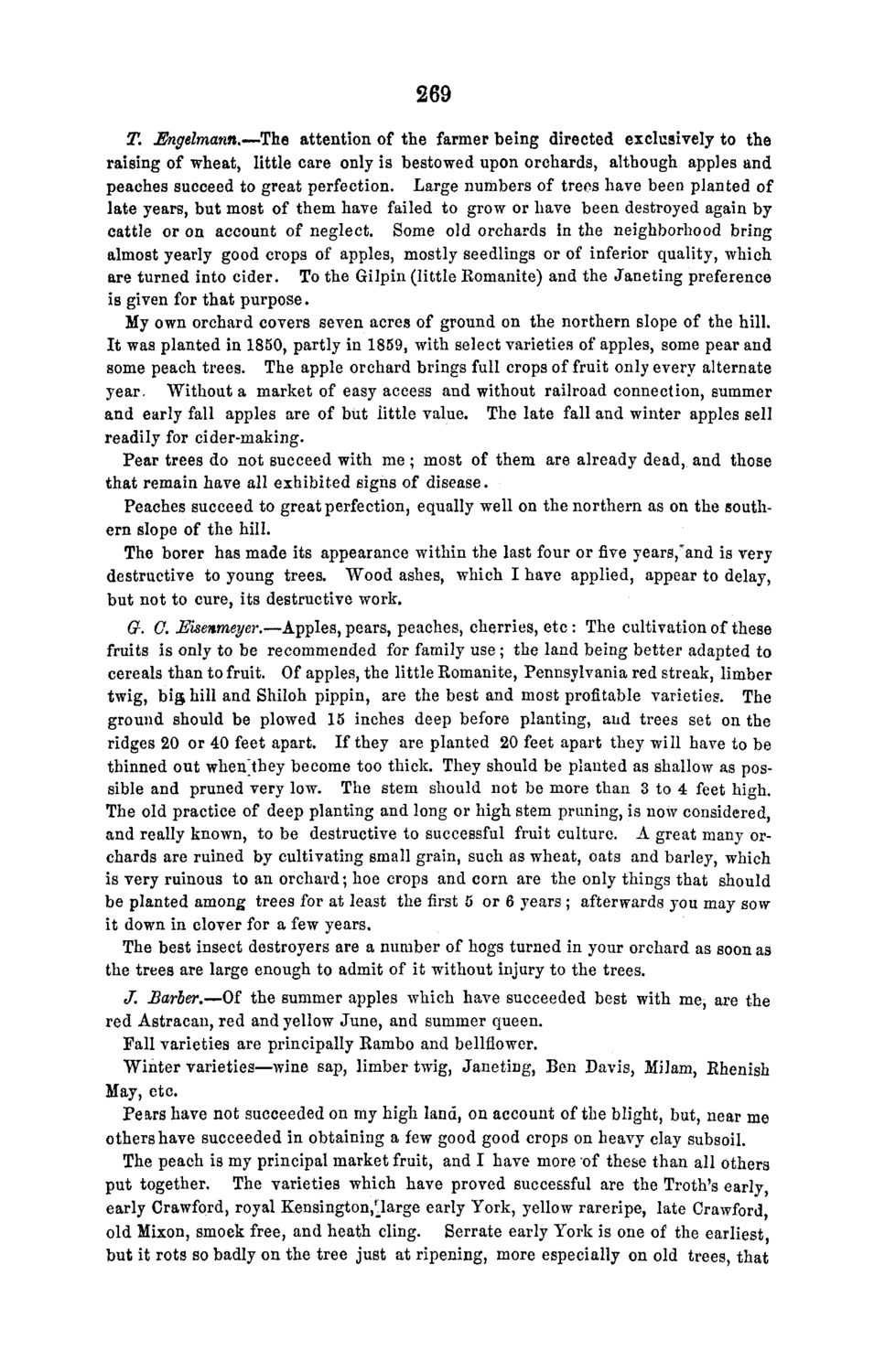| |
| |
Caption: Board of Trustees Minutes - 1868
This is a reduced-resolution page image for fast online browsing.

EXTRACTED TEXT FROM PAGE:
269 T. Engelmann*—The attention of the farmer being directed exclusively to the raising of wheat, little care only is bestowed upon orchards, although apples and peaches succeed to great perfection. Large numbers of trees have been planted of late years, but most of them have failed to grow or have been destroyed again by cattle or on account of neglect. Some old orchards in the neighborhood bring almost yearly good crops of apples, mostly seedlings or of inferior quality, which are turned into cider. To the Gilpin (little Romanite) and the Janeting preference is given for that purpose. My own orchard covers seven acres of ground on the northern slope of the hill. It was planted in 1850, partly in 1859, with select varieties of apples, some pear and some peach trees. The apple orchard brings full crops of fruit only every alternate year- Without a market of easy access and without railroad connection, summer and early fall apples are of but little value. The late fall and winter apples sell readily for cider-making. Pear trees do not succeed with me; most of them are already dead, and those that remain have all exhibited signs of disease. Peaches succeed to great perfection, equally well on the northern as on the southern slope of the hill. The borer has made its appearance within the last four or five years,"and is very destructive to young trees. Wood ashes, which I have applied, appear to delay, but not to cure, its destructive work. G. G. JEJisenmeyer.—Apples, pears, peaches, cherries, etc : The cultivation of these fruits is only to be recommended for family use ; the land being better adapted to cereals than to fruit. Of apples, the little Romanite, Pennsylvania red streak, limber twig, big hill and Shiloh pippin, are the best and most profitable varieties. The ground should be plowed 15 inches deep before planting, and trees set on the ridges 20 or 40 feet apart. If they are planted 20 feet apart they will have to be thinned out when'they become too thick. They should be planted as shallow as possible and pruned very low. The stem should not be more than 3 to 4 feet high. The old practice of deep planting and long or high stem pruning, is now considered, and really known, to be destructive to successful fruit culture. A great many orchards are ruined by cultivating small grain, such as wheat, oats and barley, which is very ruinous to an orchard; hoe crops and corn are the only things that should be planted among trees for at least the first 5 or 6 years ; afterwards you may sow it down in clover for a few years. The best insect destroyers are a number of hogs turned in your orchard as soon as the trees are large enough to admit of it without injury to the trees. J. Barber.—Of the summer apples which have succeeded best with me, are the red Astracan, red and yellow June, and summer queen. Fall varieties are principally Rambo and bellflower. Winter varieties—wine sap, limber twig, Janeting, Ben Davis, Milam, Rhenish May, etc. Pears have not succeeded on my high land, on account of the blight, but, near me others have succeeded in obtaining a few good good crops on heavy clay subsoil. The peach is my principal market fruit, and I have more of these than all others put together. The varieties which have proved successful are the Troth's early, early Crawford, royal Kensington,yarge early York, yellow rareripe, late Crawford old Mixon, smock free, and heath cling. Serrate early York is one of the earliest, but it rots so badly on the tree just at ripening, more especially on old trees, that
| |